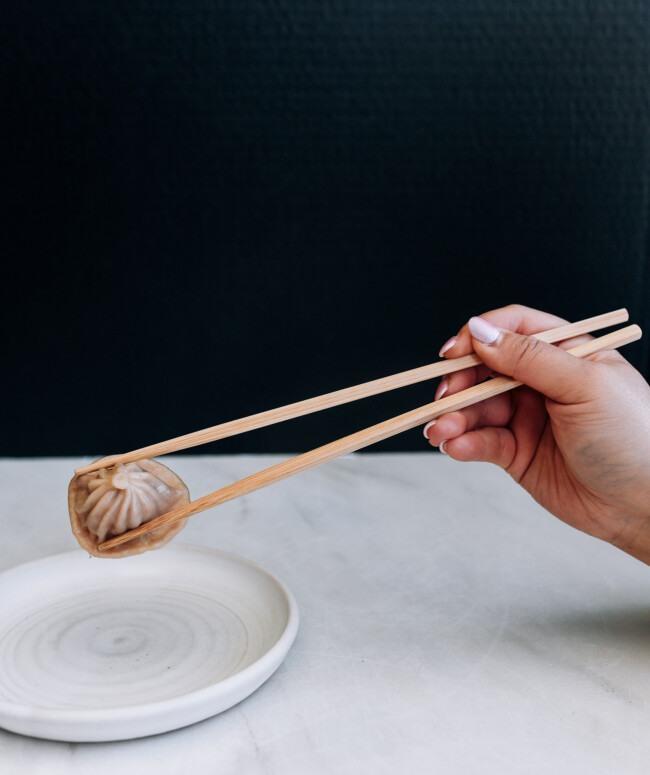How To Use Chopsticks? Top Guide
Chopsticks are probably the most versatile utensil ever. They’re a fork, knife, pair of tongs, a whisk, and a steamer stand (just place them in your wok, and they’ll hold your dish above water) all rolled into one. Learn how to use chopsticks in this post!
We’ve updated it with new information on how to use chopsticks the right way, how to store them and wash them, and what to look for when buying them. We also have a new video, so you can see it in action!
NOTE:
This post was originally published on June 10, 2013 (when The Woks of Life was only 1 week old!). We have since updated it with more detail, new photos, and a video! Enjoy.
HOW TO USE CHOPSTICKS
Chopsticks can be tricky—whether you grew up using them or you’re new to them! In fact, there are plenty of folks out there who grew up using chopsticks and can get food from point A to point B, but don’t necessarily use them “correctly.”
Some use chopsticks to spear food, though that will only get you so far. That method doesn’t hold up with noodles and rice!
SO HERE’S OUR STEP-BY-STEP GUIDE:
Step 1: Hold your dominant hand loosely. People who clench their chopsticks usually just end up flinging their food all over the place. Place the first chopstick in the valley between your pointer finger and thumb. Balance it on your ring finger.

Step 2: Place the second chopstick in the valley between your pointer finger and thumb along with the first chopstick, but rest this one on your middle finger instead of your ring finger.

Step 3: Use your thumb, pointer and middle fingers to grasp the second chopstick a bit more tightly, a bit like holding a pen or pencil (but not as tight!). Let your pinkie and your ring finger touch, supporting the bottom chopstick (i.e., the first chopstick). Your thumb will help to secure the bottom chopstick and the top chopstick.
Step 4: The first chopstick (on the bottom) remains more or less stationary. The index and middle fingers do all the heavy lifting with the second chopstick.
Using your index and middle fingers to move the top chopstick up and down, open up your chopsticks, and close them over the food. Remember to keep your hand loose, but still maintain good control over that chopstick. You’ll really be tested when picking up heavier pieces of food.
Once you’ve got a good grip, go ahead and pick it up.

And that’s it.
Pretty simple, right? You’re well on your way to chopstick mastery!

If you’re picking up something slippery or delicate (e.g. boiled dumplings, soft tofu, etc.) you can maneuver the chopsticks under the bottom of the food. Lift the food by cradling it on top of your chopstick tips. This helps avoid crushing or squishing more delicate foods.

Once you’ve learned the basics, you can also use chopsticks as a knife for certain soft foods.
Take a chopstick in each hand. Holding them at 45 degree angles, forming a cross over the food (i.e., your left hand chopstick should be to the right of you and your right hand chopstick should be to the left of you).
Drag each chopstick along the bottom of the plate in opposite directions, so the chopsticks cross over the food and in the process, cut the food in half.
COMMON MISTAKES:
- Holding your hand too low — Holding your hand too low makes it harder to open up your hand and the chopsticks. The tops may clank together before you can get very far, and you may get food or sauce on your hand. It also can create too tight of a grip that is more akin to holding a pencil than using chopsticks. (Fun fact! Our grandpa told us a story that if you hold your chopsticks low vs. high it means you’ll stick close or move far from home, respectively.)

- Holding your hand too tightly — If your whole hand is clenching, it’ll be a lot more difficult to open and close your chopsticks, which requires you to loosen your hand.

TEACHING KIDS HOW TO USE CHOPSTICKS
Funnily enough, I don’t remember much about the process of learning how to use chopsticks. I do remember that it wasn’t that difficult, and we sometimes used training chopsticks at restaurants that had them. At home we got by with a mixture of regular chopsticks and forks, and the “spearing” method.
There are more nifty training chopsticks these days than there used to be. There are roughly two kinds. Ones that are attached at the top and have finger holes to encourage kids to put their fingers in the right position, and the ones that are simply attached at the top so the chopsticks naturally hinge open and closed, making it more likely that kids will grab a hold of food.
We’d recommend starting with the finger hole version and graduating to the hinged option so that kids can practice their skills!
All that said, it’s kind of like swimming, and will come naturally. Kids wade into the water and eventually learn to swim. With chopsticks, they slowly but surely will learn to use them.
COOKING WITH CHOPSTICKS
There are all sorts of ways to use chopsticks in the kitchen–not just when you sit down to eat. You can lay two across a wok to hold a dish for streaming foods. You can beat eggs or dumpling filling, and you can also use them as more delicate cooking tools for flipping (e.g., frying potstickers, pan frying tofu, etc.) or tossing boiling noodles.
They are easy to use as you move around the kitchen from task to task and they also avoid breakage on delicate foods like noodles or tofu, which can easily be damaged by metal tongs.
Bottom line, we’re always reaching for a fresh pair of chopsticks!
WHAT CHOPSTICKS SHOULD I BUY?

When buying chopsticks, we prefer the sturdy and traditional bamboo versions. Bamboo ones usually come in two styles—ones with uniformly cylindrical ends and ones with more tapered ends.
Either works, and it comes down to personal preference. The ones with tapered ends do have less surface area, so it can be trickier for first-timers, though with bulkier chopsticks, you have less dexterity to pick up very small or thin pieces of food.
The best place to buy these may be a local Chinese or Asian grocery store, where you can really get a sense for what they look like. They also make more ornate bamboo versions these days, if that’s your fancy.
Disposable chopsticks have a time and place and we almost always save them for road trips or airplane rides. (If you’re Bill, you even use them as anchors to fill holes for screws in walls, door hinges, and even masonry.)
Melamine chopsticks (i.e., those fancy glossy ones you often see at Chinese restaurants) can get a bit slippery, and food is harder to handle. They are also slightly more hygienic if you are worried about avoiding the natural bamboo material. You may want to have a set on hand for nicer occasions. We generally avoid plastic chopsticks.
If you see metal chopsticks out there, they’re probably Korean-style! These are heavier and often thinner or squared off. Japanese chopsticks tend to be shorter, with finer, pointier ends. Both of these styles can be more difficult to use for beginners.
USING CHOPSTICKS FOR STEAMING FOOD
If you don’t have a metal rack for steaming a dish of food in your wok, you can use a pair of bamboo, wood, or metal chopsticks! (Don’t use any that are plastic or melamine, which can melt.)
Just place them a few inches apart across the base of your wok (the water in the wok shouldn’t be touching them), and place the plate on top.

HOW TO WASH CHOPSTICKS
The best dishwashers for washing chopsticks are ones that have a flat top rack for utensils. That way, they aren’t sliding through a utensil basket and getting caught in the bottom of your dishwasher. (This can cause them to break when you pull the dishwasher rack out.)

If you do have a utensil basket, you can place a piece of parchment paper at the bottom of your utensil basket to avoid the chopsticks from sliding through (a pro tip from our cousin Kim), or thread them through the holes at an angle so they stay in place through the wash cycle.
That said, the best way to wash bamboo chopsticks may simply be with hot water and a lightly soapy sponge. Bamboo tends to absorb the dishwasher detergent and can take on a soapy taste.
Judy also noticed that if she soaked chopsticks fresh from a dishwasher in a bowl of clean water, the water would become slightly sudsy. This may not bother you, but it’s why we usually default to hand washing!
We use a sponge to get solids off. Then roll a handful of chopsticks between our palms to shake the water all around them and get them clean. (If you don’t have a big bunch, just rinse them well.)

From there, lay them flat to dry in a single layer on a clean kitchen towel or drying rack.
Allow them to dry completely before putting them in your drawer. If you put chopsticks away before they are completely dry, they may grow mildew.
STORING CHOPSTICKS
As mentioned, most utensil drawer organizers will have a long enough compartment to fit chopsticks. We like these bamboo ones! That’s how we store most of our chopstick collection.

If you have multiple sets of chopsticks, you can secure them with rubber bands and store them that way. With so many sets for food staging and blogging, that’s what we do with the ones that aren’t in daily rotation!

Another popular option for storing chopsticks is to place them in a utensil holder or repurposed jar/vase right on the kitchen counter or dinner table. That way, they are always close at hand.
This also helps avoid the mildew issue as they are always standing upright. You’ll want to store them with the bottoms inside the vessel. This keeps the ends clean and makes them easy to grab.
Take a look at the chopsticks on our Chinese cooking tools page and see our preferred choice of bamboo chopsticks. Or follow this Amazon link and shop for all kinds of chopsticks!
You’re well on your way to chopstick mastery.






